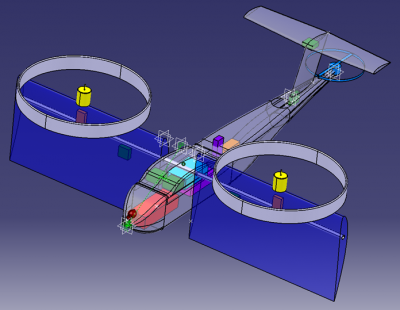Inhaltsverzeichnis
Development of an Autonomous Flight Control System for Micro Aerial Vehicles
In recent years the research and development of autonomous aerial vehicles has increased.
Unmanned aerial vehicles (UAV) can be used to observe areas or provide services, such as an
emergency GSM network, if these services fail due to heavy overload during catastrophic
events. Besides, there are many more application areas for autonomous aerial vehicles.
Micro aerial vehicles represent a subclass of UAVs and are reduced in size and weight.
From the engineering point of view, an operator, leading the MAV to the right position, usually controls MAVs
manually. This thesis adds an information theoretic approach to MAVs in a way, that tasks of the MAV are
automatized. A task would be, for example, to identify a specific object, fly autonomously a route between two trees
without collisions. Depending on the distance between the trees, this task is hard to accomplish for humans.
The architecture of the control system consists of a micro controller unit (MCU), a
sensor unit and a camera unit. The camera unit evaluates frames and provides flight
route recommendations to the MCU. These signals are then compared and
evaluated with the signals provided by the sensor unit. All signals are then analyzed
and evaluated in real-time to make a decision. The sensor unit contains an inertial
measurement unit (IMU) and a GPS receiver. Within the IMU there is a gyroscope,
ultra sonic measurement unit and air pressure sensor. The IMU data and the GPS
data are directly evaluated by the MCU. The camera unit consists of an ARM A8 processor and a camera to evaluate
frames and transmit the evaluation to the MCU. The camera is connected via the universal serial bus (USB) and the
ARM A8 board is connected via the UART serial interface to the MCU, since the frame evaluation and thus the main
data throughput is performed on the ARM A8 processor.

The goal of this master thesis is to develop an autonomous flight control system, running on resource constraint
embedded systems. Hardware constraints include a small size and a low weight, since a higher weight requires more
powerful aircraft engines. These hardware constraints induce strict software constraints, since resources like
computational power are limited. Nevertheless, the airspeed of the MAV provides another challenge, since MAVs
cannot be stopped within flight and data processing has to be performed fast and in real-time. The Institute of Flight
System Dynamics at RWTH Aachen University, constructing a MAV, supports the information theoretic approach by
providing controller models. The development, implementation, integration and testing of the autonomous flight
control system is performed within this master thesis.
Status
C. Dernehl is currently working on this thesis.